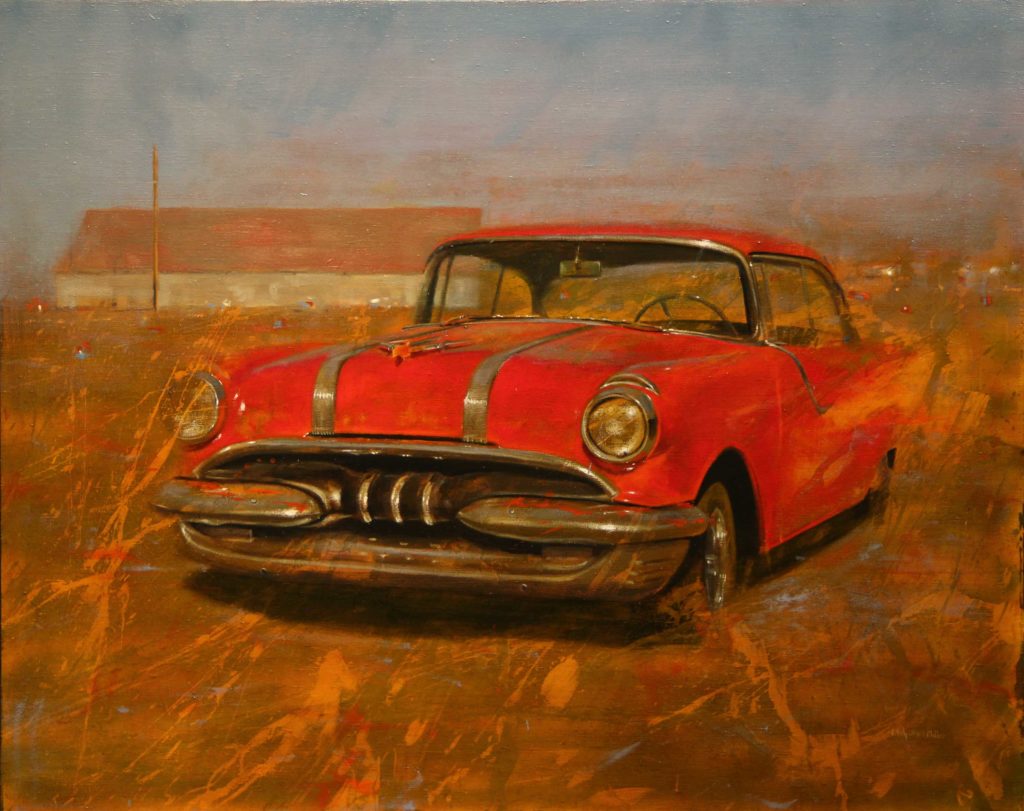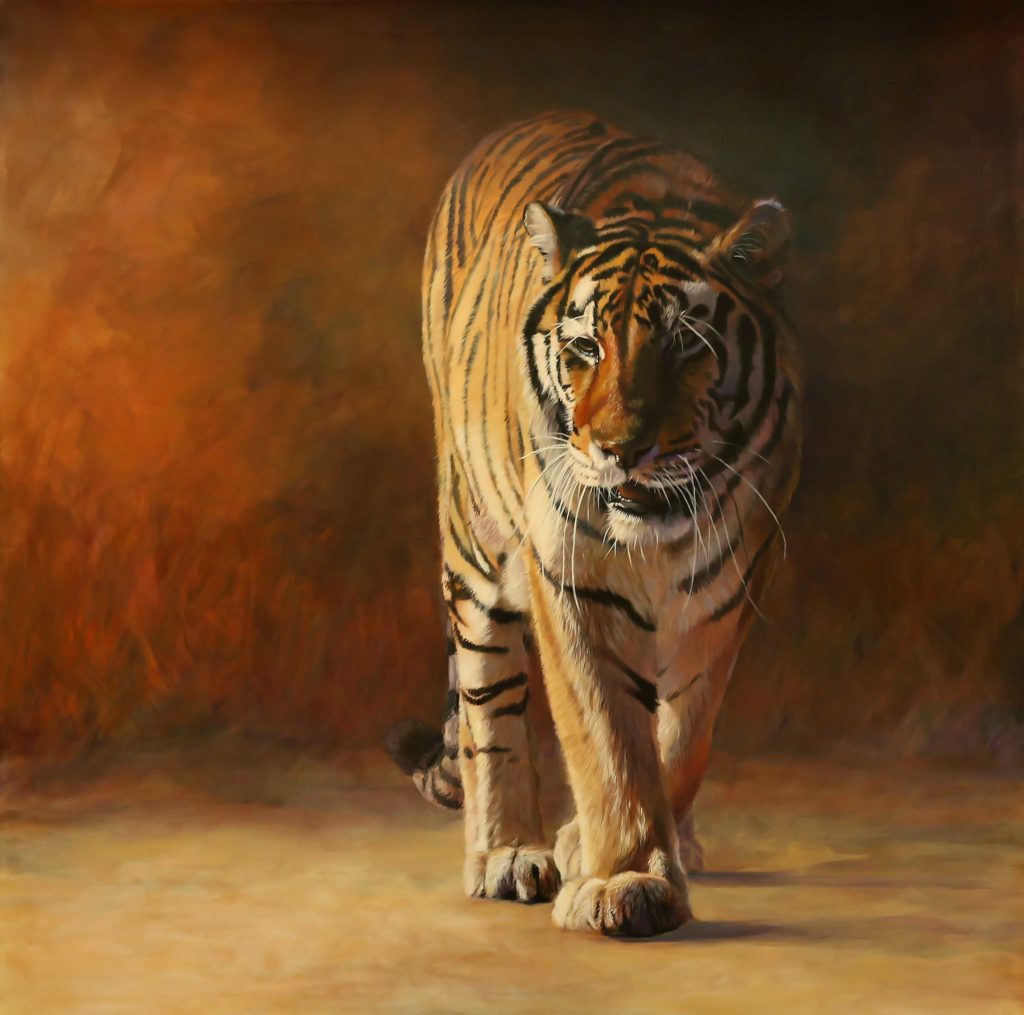
The first thing you notice while viewing a painting by Jason Drake is the palette. His neutral tones and limited range of colors complement his naturalist style, which is clearly inspired by the pared-back yet poignant paintings of Andrew Wyeth. Surveying Drake’s oeuvre, it also becomes apparent that he is most at home outdoors. Nature seems to be where he and his subjects can breathe a bit easier, where freedom and reverie are welcome.
As simple and pure as the outdoor settings can be, Drake’s paintings are not merely recordings of nature’s beauty and fleeting moments. Rather, his works present the landscape as a backdrop to a central character’s narrative, and they are often filled with symbolism. Take the painting “The End of Summer,” in which a young girl clothed in white is enjoying an exultant moment on a bright day. She closes her eyes and sings, unaware of anyone or anything around her, including the flock of geese following her lead. They seem to be silent, except for the second bird, who is not keeping time with the rest. Perhaps the birds are not literal, but rather represent an aspect of this girl’s story. Only the artist knows for sure, and with a title that signifies a season passed, we are left to ponder.
With so much thought, observation, and reflection behind each piece, it is clear why Drake’s paintings frequently cause viewers to pause. The layers of meaning and sense of timelessness behind the “simple” surface suggest the artist’s main motivation for creating. “Art has the power to move us,” Drake says, “and a painting’s composition carries the ability to capture our thoughts and emotions. I have found that things, objects, hold deep meaning for us because we put them into the context of our own experiences. I want people to sense a deep spark rather than a quick flash when viewing my compositions. I am not trying to sensationalize or be sentimental in the subjects I choose. I want to represent real lives, real things, and real places that have beauty in and of themselves.”
Jason Drake Drake is represented by Blowing Rock Frameworks & Gallery (Blowing Rock, NC) and Collins Galleries (Orleans, MA).

Kate Kilpatrick-Miller makes oil paintings that explore themes of both stillness and movement, often symbolically representing bygone seasons of life or current moments of vitality and momentum. Nostalgia, contemplativeness, and melancholy are as present in her imagery as feelings of rhythm, flow, and energy. This confluence of calm and activity is, according to the artist, the heartbeat of both the human and artistic experience.
Falling somewhere between stillness and movement are Kilpatrick-Miller’s depictions of cars, especially vintage ones. Her painting “Off the Highway” features a fire-engine red Pontiac Chieftain from the 1950s, once a popular means of transportation, now a retired relic. The artist’s use of sepia tones surrounding the vehicle gives us a greater sense that we are back in time, and, although the car now sits abandoned in a field, we are reminded of its continuing aesthetic and historic value. “Vintage cars in particular appeal to me visually because of their contour and color,” the artist says. “The car in the field may carry a certain melancholy because it is no longer used as a mode of movement, but it also carries a proud heritage.”
Kilpatrick-Miller’s sensitivity to the passage of time is apparent in all of her subject matter. Whether it’s a collection of shoes from years past, a memorial mural to her hometown’s baseball team, or a vignette of a child’s tricycle, it’s clear that the artist pays close attention to and appreciates the stories that surround her. Kilpatrick-Miller brings this worldview to the community projects she spearheads in her hometown of Helper, Utah. She is currently working on “The Faces of Helper” series — recording locals’ stories about their heritage while painting their portraits — as well as a collaborative interactive mural project to support local tourism.
Kate Kilpatrick-Miller is represented by K2 Gallery (Helper, UT) and Trove Gallery (Park City, UT).

Anni Crouter has been painting portraits of wild and domestic animals for more than 30 years. Her artistic calling began during childhood, when she was continually surrounded by animals. Growing up on a farm with a father who was a veterinarian, she spent countless hours in his clinic and was communicating through art before she could read or write. Her mother and both of her grandmothers strongly encouraged her artistic tendencies, and she began to sketch what was available in her immediate surroundings: horses, barn cats, dogs, birds, and more.
Crouter’s love of animals and art continued to develop in tandem, and after a brief attempt at pursing veterinary medicine herself, she realized she could better serve her subjects through her artistic talents. Crouter eventually married a veterinarian, and today she has a studio space in the same building as his practice. “He fixes them and I paint them,” the artist writes of their synergistic relationship and shared love of animals and art.
Although Crouter paints architectural subjects, landscapes, and florals as well, it is her wildlife work that has brought her the most recognition in recent years. Finding the subject matter to work from is often the hardest part of Crouter’s practice. She frequents the Detroit Zoo in her home state of Michigan — the tiger pictured in “Kol’s Noble Stroll,” a longtime favorite of the artist, lived there until his recent passing — and has traveled to zoos around the country in pursuit of such species as the clouded leopard, polar bears, and African wild dogs.
The artist first began painting in oils and acrylics, but now paints primarily in watercolors. Although she minored in art during college, she credits her breakthrough as a painter, particularly in color, to her ongoing study with mentor Jim Ames. “I’ve been studying with Jim for more than 24 years,” Crouter says. “A teacher at the Flint Institute of Arts, Jim is a master at color theory and has devoted his life to the subject. My growth as a painter has accelerated exponentially under his guidance.” Whether in color or form, Crouter’s subjects leap off the canvas and speak of her enduring dedication to the domestic animals and wildlife she has loved since childhood.
Anni Crouter is represented by Mackinac’s Little Gallery (Mackinac Island, MI) and Twisted Fish Gallery (Elk Rapids, MI).
This article originally appeared in Fine Art Connoisseur magazine (subscribe here).
Sign up to receive Fine Art Today, the weekly e-newsletter from
Fine Art Connoisseur magazine.






